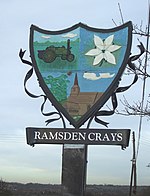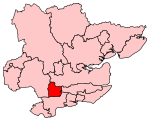Crays Hill
Borough of BasildonEssex geography stubsVillages in Essex

Crays Hill is a village in the Basildon borough of Essex, England. The River Crouch passes under Church Lane.The village was listed in Domesday Book of 1086 when the Lord of the manor and tenant-in-chief was Sasselin of Layer.Crays Hill was part of the civil parish of Ramsden Crays until 1934 when it was abolished to enlarge South Hanningfield.
Excerpt from the Wikipedia article Crays Hill (License: CC BY-SA 3.0, Authors, Images).Crays Hill
Crays Hill, Essex
Geographical coordinates (GPS) Address Nearby Places Show on map
Geographical coordinates (GPS)
| Latitude | Longitude |
|---|---|
| N 51.602 ° | E 0.4708 ° |
Address
Crays Hill
Crays Hill
CM11 2XJ Essex, Ramsden Crays
England, United Kingdom
Open on Google Maps








